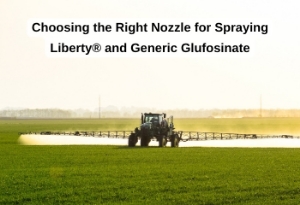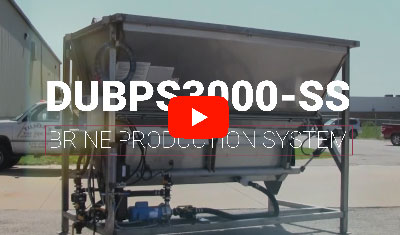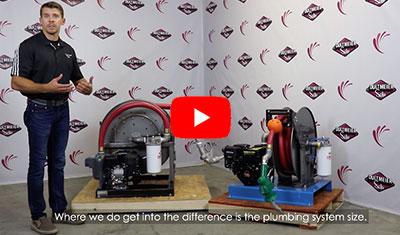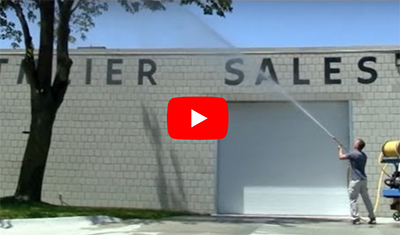
Liberty herbicides and their generic alternatives present growers with a challenge: finding nozzles that balance coverage and drift control while staying within label requirements.
It’s a challenge we face, too. At Dultmeier, we understand spray nozzles—their droplet size, spray pattern, and flow rate—but many variables (chemical type, tank mix, rate, speed, weather) make it impossible to recommend a single nozzle for every situation.
Instead, our goal is to compile the best available information and help you choose the right setup for your needs.
This guide covers which nozzles can provide the droplet size needed for glufosinate (Liberty) use on U.S. corn and soybeans, backed by label requirements, university research, manufacturer guidance, and real-world feedback. As always, the label is the law—and it must be followed.
TL;DR: Key Takeaways for Liberty® Nozzle Selection
Dultmeier Sales can help you size the right spray nozzle, but always consult the label and your agronomist for product-specific recommendations. |
Why Nozzle Selection Matters for Liberty®
Liberty® kills almost any plant it touches — including glyphosate-resistant weeds — but it only works where it makes contact. That means full coverage of weed leaves is essential. To get the job done right, you need a nozzle that provides excellent leaf coverage while minimizing drift, especially near non-LibertyLink® crops.
What the Liberty® Herbicide Label Says
According to the Liberty® 280 SL label, you need to use a nozzle that has medium to coarse droplets:
“Apply with nozzles and pressure that deliver medium to coarse spray droplets as indicated in nozzle manufacturer’s catalogues and in accordance with ASABE Standard 572…”
Source: BASF - Label Liberty® 280 SL (I highly recommend reading to fully understand the requirements)
Understanding this, there are some logical follow-up questions:
- What is a medium to coarse droplet?
- Which spray nozzles are available to produce medium to coarse droplets?
Let's break down the answer to each of these questions.
Understanding Droplet Size Requirements for Liberty® Herbicide
In the world of agricultural spraying, "medium" and "coarse" droplet sizes are defined by ASABE Standard S572.1, which classifies spray droplets based on their Volume Median Diameter (VMD)—the point at which half the spray volume consists of droplets smaller than the listed size and half are larger.
- Medium droplets range from 226 to 325 microns in diameter.
- Coarse droplets range from 326 to 400 microns.
Turbo TeeJet Nozzle Medium to Coarse Droplets Demo:
These sizes strike a balance between coverage and drift control—a critical factor when applying contact herbicides like Liberty®, which require even leaf surface coverage but also must avoid off-target drift, especially near sensitive crops.
For comparison:
- Fine droplets (<225 microns) provide excellent coverage but drift easily.
- Very coarse and larger droplets (>400 microns) are more drift-resistant but may lead to poor weed control if they don't cover the leaf surface adequately.
Want a deeper dive into how these droplet sizes affect spray performance, coverage, and herbicide effectiveness? Check out this detailed breakdown. It’s a must-read if you want to gain a thorough understanding of droplet sizes and how they affect your spray quality.
Nozzles That Deliver Medium to Coarse Droplets for Liberty® Application
There are several nozzles available that will produce medium to coarse droplets. The key is making sure that a nozzle series will produce this droplet size across the pressure range you operate and the nozzle size you use.
Nozzle size affects the droplet size; larger sizes typically create a larger range of droplets relative to smaller sizes within the same family. Refer to the spray nozzle chart for a given nozzle type to understand this in more detail.
BASF has provided specific nozzle types from TeeJet with guidelines for application. These are the nozzles that they are recommending to maintain the coverage needed to cover the plant tissue.
BASF Recommended TeeJet Nozzles:
Nozzle Brand | Nozzle Series | Sprayers with PWM Systems |
|---|---|---|
TeeJet | Yes | |
TeeJet | Yes | |
TeeJet | No | |
TeeJet | Yes |
Source: TeeJet Liberty Spray Tip Recommendations
Note: Dultmeier Sales does not endorse a specific nozzle for every application. The information provided reflects guidance from BASF and TeeJet Technologies. It is the responsibility of each applicator to understand the products they are using and to ensure all applications are made in full compliance with the product label.
Nozzles that Produce Medium to Coarse Droplets
Greenleaf and Wilger also offer nozzles for excellent coverage. The Greenleaf TurboDrop Dual Fan has been used very effectively with Liberty. There are also other good options. These nozzles listed below offer the medium to coarse droplet size called for when applying Liberty® and provide some drift control as well:
Nozzle Brand | Nozzle Series | Sprayers with PWM Systems |
Greenleaf | ||
Greenleaf | ||
Greenleaf | ||
Greenleaf | Yes | |
Wilger | Yes | |
Wilger | Yes |
Follow Recommended Application Guidelines
In addition to the nozzle type, application practices are extremely important for drift reduction and coverage. Again, we can refer to what the label says. In this case, it covers several different factors:
Drift-Reducing Surfactants
- "Addition of some drift retardants can significantly increase the droplet size and reduce spray coverage and efficacy. If a drift retardant is used, ensure that it is compatible for use with Liberty 280 SL and spray equipment being used."
- Implication: Compatible drift agents must not compromise coverage.
Source: Application Instructions section
Boom Height
- "DO NOT exceed a boom height of 24 inches above target pest or crop canopy... Set boom to lowest effective height... Excessive boom height will increase the potential for spray drift."
- Implication: Lower boom height reduces drift and improves spray pattern.
Source: Spray Drift Mitigation section
Spray Speed
- While spray speed isn’t explicitly named, the label does warn against boom bounce and turbulence:
"Boom should remain level with the crop and have minimal bounce." - Implication: Excessive ground speed increases turbulence and bounce, raising drift risk. Generally, speeds above 10 Mph can greatly increase drift with non-air induction flat fan nozzles.
Source: Spray Drift Management section
Pressure
- "Use the lower spray pressures specified for the nozzle. Higher pressure reduces droplet size and does not improve canopy penetration... Use a higher-capacity nozzle instead of increasing pressure."
- Implication: Lower pressure = bigger droplets = less drift, but may reduce coverage.
Source: Techniques for Controlling Droplet Size
Droplet Size and Coverage
- "The most effective way to reduce drift potential is to apply large droplets...."
- "Liberty 280 SL is a contact herbicide and requires proper nozzles with uniform, thorough spray coverage to achieve optimum weed control."
- Implication: Medium to coarse droplets balance drift and coverage.
Source: Advisory Spray Drift Language & Spray Droplet Guidance
Application Guidelines for Liberty Herbicide:
University Research: What the Experts Say About Nozzle Selection for Liberty®
When it comes to applying Liberty® (glufosinate) effectively, university research clearly supports what the product label already emphasizes: droplet size matters—a lot.
Medium to Coarse Droplets Are a Must
Because Liberty is a contact herbicide, every leaf surface needs to be covered for the product to work. The University of Minnesota Extension states that “proper nozzle selection and carrier volume are key in achieving adequate spray coverage,” reinforcing the label’s requirement for medium to coarse droplets during application. These droplet sizes help ensure good coverage while also minimizing drift.
This message is echoed by Iowa State University, which highlights that using the right nozzle and enough water volume is critical for optimizing glufosinate performance.
Coarse Droplets Can Still Deliver Results
Don’t assume bigger droplets mean poor performance. Field trials from the University of Nebraska found that even with coarse droplets (~600 microns) and a low carrier volume of 5 GPA, Liberty was still able to achieve around 90% of maximum weed control, all while reducing drift potential. That said, increasing GPA (e.g., 15–20) further boosts consistency.
Generic Liberty® Alternatives
Other generic products that contain the same active ingredient, glufosinate-ammonium, provide their own guidelines on application. When using generic versions of Liberty herbicide, always read the label carefully—some products may not be approved for all LibertyLink crops.
While most generics share similar droplet size and drift control requirements with Liberty, it's important to confirm these details on the label. Also, surfactant and adjuvant recommendations can vary, so check compatibility with tank mix partners before spraying.
Key Takeaways
Choosing the right spray nozzle for Liberty® herbicide is key to getting effective weed control while avoiding drift. As a contact herbicide, Liberty requires full leaf coverage—achieved with medium to coarse droplets as specified on the label.
Research and field experience show that droplet size, pressure, boom height, speed, and water volume all affect results. Nozzles like TeeJet’s AIXR, TT, and TTJ60 or Greenleaf’s AirMix®, TurboDrop®, and TADF DualFan can hit the right droplet range when used properly.
If you're using a generic version of glufosinate, always read the label—crop approvals and adjuvant recommendations may vary.
Bottom line:
- Follow the label—it’s the law.
- Use nozzles that produce medium to coarse droplets.
- Use the right GPA and boom height for good coverage and low drift.
- Check compatibility for surfactants, tank mixes, and generics.
At Dultmeier, we specialize in sizing spray nozzles for conventional and PWM systems. For help, call us and we can explain the droplet size and spray pattern that any given nozzle will do; however, we are not experts on the herbicides or tank mixing methods themselves. Be sure to consult the product label and an agronomist for more guidance.

Tech Ag & Industrial Sales
Shane Blomendahl is a tech sales veteran at Dultmeier Sales with over 10+ years of experience in liquid handling products covering several industries and applications.










